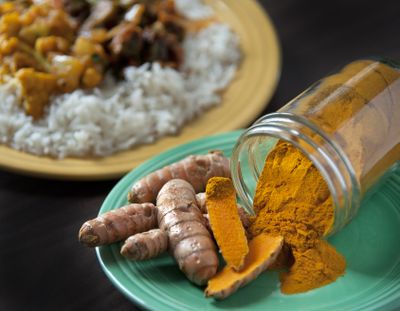The root of all goodness
Raw fresh turmeric elevates flavors with a savory sweet combination

Powdered turmeric is the main component in curry spice. Fresh turmeric is livelier and packs more savory goodness than the dried counterpart. It can bring ethnic-style food to life.
Common to Asian cooking, turmeric comes from the rhizome – or root – of Curcuma longa, a plant closely related to ginger. The rhizomes are quite similar in appearance to ginger root, just smaller and more colorful.
Peeled and sliced, raw fresh turmeric has a deep orange color and a flavor reminiscent of carrots, plus qualities of citrus, cedar, earth and dust. It also has a lemon-like zing similar to ginger.
Fresh turmeric is outstanding in Asian-style braised or sautéed dishes, and it can bring vegetarian dishes – a mainstay of food in India – to life. Use it in dishes with eggs, lentils, noodles and tofu. The spice lends a special character to build up flavors when paired with simple ingredients.
Turmeric also combines nicely with sweet ingredients.
Add fresh turmeric to a morning fruit smoothie – its savory quality works well with the natural sweetness and acidity of fruit blended with milk, yogurt, wheat germ or milled flax. Soy, almond, rice, quinoa or coconut milks work well in turmeric-spiced smoothies. Also, try a little black pepper or cardamom seed for even more zip.
Or, make a juice extraction of cucumber, lemon, carrot and lettuce.
As you can see, the sky is the limit. Just don’t use too much. Generally, an inch or two of the rhizome is plenty to spice a dish adequately.
Ajit Khinda, co-owner of Taste of India restaurant, 3110 N. Division St., said that the secret to India-style spicing is to use its strong-flavored spices in balance and not let them overpower a dish.
One of Khinda’s cooks, Balwinder Kaur, whipped up two dishes with fresh turmeric using cauliflower in one dish and okra in the other. Both were fabulous.
While Taste of India uses dried and powdered turmeric in its kitchen, Khinda said that adventurous diners who want to try fresh turmeric cooked properly should bring some of their own turmeric rhizomes to the restaurant and ask for an a la carte serving from the house cooks. The cost is about $11 for a dish.
The spices that complement turmeric are black pepper, cardamom, hot chili, cumin, curry, ginger, coriander and mustard. (Yellow mustard gets its color from turmeric.)
Any recipe that calls for powdered turmeric can be enlivened with fresh turmeric, or some of both.
When replacing powdered with fresh turmeric, the proper amount of fresh turmeric is roughly double the volume of powdered turmeric.
Fresh turmeric is available locally at Asian and specialty food stores in Spokane, including Main Market and Huckleberries. Prices for fresh turmeric vary from $6.99 a pound at Asian markets to $17.99 a pound for organic turmeric.
As with ginger root, the skin of turmeric root is bitter and should be peeled. Use a grater when adding the peeled root to a dish.
A few words of caution: the rhizome’s yellow color can stain utensils, kitchen towels, cutting boards, countertops and fingers.
Simply rinse your fingers and utensils quickly to reduce staining and drop peels onto waxed paper or other disposable surface.
Turmeric has been used for centuries in traditional Asian medicine. The powdered version is created by boiling the root, drying it and pulverizing it. But powdered turmeric loses its flavor relatively quickly, which may be the reason it so often seems unremarkable when added to a dish.
Health-food advocates say turmeric has anti-inflammatory qualities that alleviate a range of maladies.
Its most active compound, curcumin, is being investigated for its potential medicinal benefits. One study from Ohio State University, published last year, showed that curcumin is not easily absorbed into the body during digestion. The study suggested that finding a way to make curcumin effective as an anti-inflammatory would be worth the effort.
Nutritional analysis shows that turmeric contains good amounts of omega-3 and omega-6 fatty acids along with iron, manganese and small amounts of other nutrients.
Vegetables With Turmeric
From Taste of India in Spokane
1/2 cup diced onion
1 tablespoon vegetable oil
Pinch each of coriander, cumin, dried or fresh chili, cloves, cardamom, black pepper
1 teaspoon chopped garlic
1 teaspoon chopped ginger root
2-inch segment of fresh turmeric, grated
2 cups cauliflower pieces
Start by sautéing onion in vegetable oil on medium-low heat for a minute or so. Add the spices. Then add the garlic, ginger and fresh turmeric. Stir and let them heat up in the pan until the spices and garlic bloom and their fragrance is apparent. Add the cauliflower (or vegetables of choice) and sauté gently for 6 to 7 minutes. (Diced potato is a good companion in this dish.) Salt to taste.
As an alternative, add a half cup of broth or non-dairy milk or some of both to the pan once the vegetables have been coated and cook them in a braise style. Cook uncovered so the liquid can evaporate and thicken into a sauce.
Meat or tofu pieces will also work in this dish.
Yield: 2 servings
Turmeric Smoothie
1-inch segment of fresh turmeric, peeled and sliced.
1 cup of fruit pieces (strawberries, blueberries, banana, etc.)
1 tablespoon of wheat germ, milled flax seed, etc.
1 cup of milk (non-dairy milk is good, or a combination of milk and water)
Small pinch of crushed peppercorns
Small pinch of crushed cardamom seed
Pinch of cinnamon
1 tablespoon agave syrup or sugar (if desired)
Peel and slice the turmeric. Crush the peppercorns and cardamom seed with the side of a chef’s knife blade. Place prepared ingredients in a blender and let her go. Frozen fruit helps make the smoothie cold. It might take 30 seconds to blend the ingredients. Serve immediately.